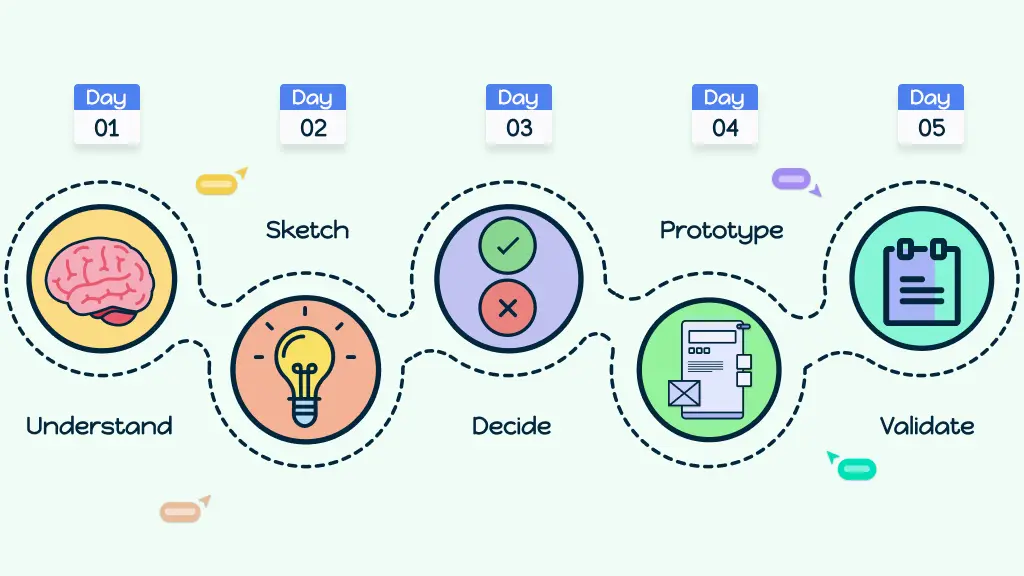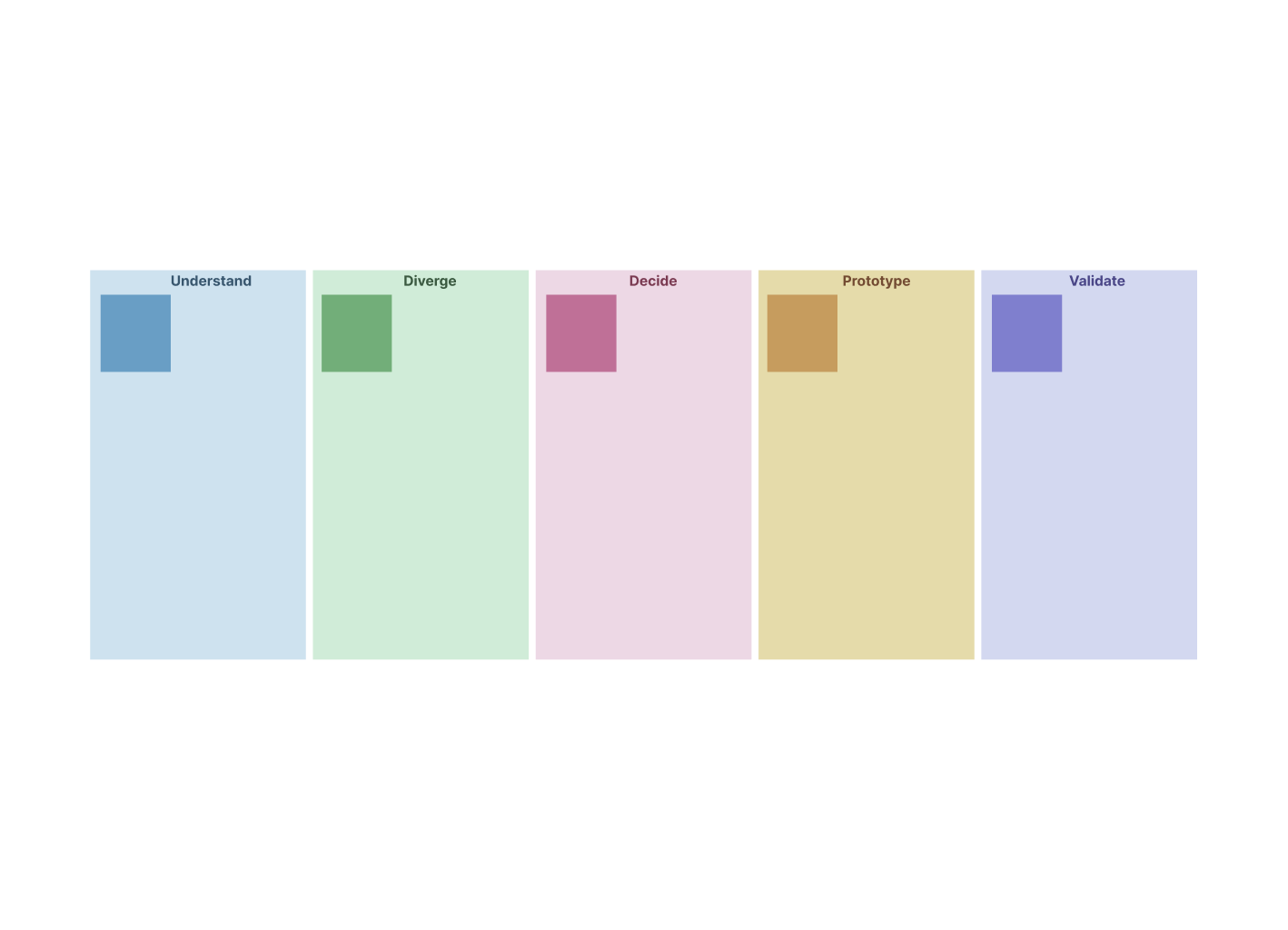A design sprint is a fast, structured way to solve problems and test ideas in just a few days. Instead of spending months on guesswork, the design sprint process helps teams quickly prototype and learn from real users. It matters because it speeds up decisions, reduces risk, and aligns everyone around clear next steps.
The 5 Core Phases of the Design Sprint Process

Phase 1. Understand & define the challenge
The sprint starts by digging deep into the problem you want to solve. The team gathers insights from experts, reviews existing data, and maps out the customer journey. The goal is to clearly define the challenge and agree on a long-term target. Without this shared understanding, the rest of the sprint risks heading in the wrong direction.
Phase 2. Ideate & sketch possible solutions
Once the challenge is clear, it’s time to generate ideas. Everyone works individually at first, sketching out possible solutions instead of brainstorming out loud. This way, every voice is heard and the team ends up with a diverse set of creative options to consider.
Phase 3. Decide & storyboard the approach
With lots of ideas on the table, the team votes and discusses to pick the most promising direction. The chosen idea is then turned into a step-by-step storyboard. This acts as the blueprint for the prototype, ensuring everyone knows what they’re building and why.
Phase 4. Prototype a realistic version
The team quickly builds a prototype — not a polished final product, but something real enough for users to interact with. The trick is to focus only on what’s needed to test the idea. A good prototype makes the concept feel tangible without wasting time on unnecessary details.
Phase 5. Test with users and gather insights
Finally, the prototype is put in front of real users. By observing how they interact with it and listening to their feedback, the team learns what works, what confuses people, and what needs to change. These insights provide a clear path forward — whether that means refining the idea, pivoting, or moving ahead with confidence.
Variations of the Design Sprint Process
| Sprint Type | Origin | Structure | Advantages | Best For |
| Classic 5-day Sprint | Created at Google Ventures by Jake Knapp and team |
|
|
|
| 4-day Design Sprint 2.0 | Popularized by AJ&Smart as a faster, more efficient approach |
|
|
|
| Lightning / Mini Sprints (1–3 days) | Adapted for quick insights and alignment |
|
|
|
Key Roles in the Design Sprint Process
A design sprint works best when the right people are in the room. Each role has a clear purpose, and together they keep the process moving smoothly.
Facilitator
Guides the team through each phase of the sprint
Keeps time, ensures everyone’s voice is heard, and maintains focus
Neutral role — doesn’t push their own ideas but makes sure the process runs smoothly
Decider
The person with final say (often a product lead, manager, or stakeholder)
Breaks ties when the team is split
Ensures the sprint outcomes align with business goals
Design and tech experts
Designers contribute visual thinking and user experience skills
Engineers or developers bring technical know-how and highlight what’s feasible
Together, they make sure ideas are both creative and practical
User researcher
Plans and runs the user testing on the final day
Makes sure the right participants are recruited
Helps interpret feedback so the team gets reliable insights
Turning Design Sprint Insights into Actions
Synthesizing user feedback
After testing, the team reviews how users interacted with the prototype. The goal is to spot patterns, highlight what worked, and uncover areas of confusion. Focusing on actionable insights helps guide the next steps without getting lost in every single comment.
Deciding next steps
With feedback in hand, the team decides whether to iterate on the idea, pivot to a new approach, or move forward with confidence and launch. Involving the decider and key team members ensures alignment and clear decision-making.
Integrating sprint outcomes into product development
The results from a sprint feed directly into the product roadmap. By using real user insights to prioritize features and plan work, teams reduce wasted effort and foster a culture of rapid learning — sprint, test, iterate, and scale.
Visual Templates for the Design Sprint Process
Using structured templates can make design sprints more efficient, organized, and easier to follow. They provide clarity at every step and help the team focus on solving the right problem.
1. User journey & empathy map
These templates help the team visualize the user’s experience from start to finish. Mapping out steps, pain points, and motivations ensures the solutions you generate are user-centered. It also highlights areas where improvements can have the biggest impact.
2. Idea & sketch templates
Idea and sketch templates give structure to brainstorming sessions. Team members can individually sketch solutions, which encourages creativity and ensures all ideas are considered. Later, these sketches can be compared and discussed to select the most promising concepts.
3. Decision & storyboard template
After ideation, this template helps the team make decisions and plan the prototype. It captures the chosen solution and outlines each step in a storyboard format, so everyone knows what to build and why. This ensures the prototype reflects the team’s best ideas.
4. Prototype & test template
This template guides the creation of a realistic prototype and organizes user testing. It includes what features to include, how to test them, and how to record feedback. Using it ensures the team gathers meaningful insights without wasting time on unnecessary details.
5. Sprint retrospective template
After the sprint, retrospective templates helps the team reflect on what went well, what didn’t, and what can be improved next time. It’s a crucial tool for continuous improvement and makes each sprint more effective than the last.
Accelerate Your Design Sprints with Creately AI
Creately AI is an integrated assistant within Creately’s visual workspace, designed to streamline and enhance the design sprint process. Here’s how it contributes:
- AI design sprint template: Automatically creates a step-by-step sprint plan, including mapped activities, questions, and templates, based on a brief input. This feature accelerates the setup phase, allowing teams to focus more on execution.
Real-time collaboration: Facilitates synchronous and asynchronous collaboration among team members, regardless of location, ensuring alignment and efficient workflow.
Integrated visual tools: Provides a suite of visual tools to map user journeys, sketch ideas, and storyboard solutions, all within a cohesive platform.
Export and integration capabilities: Allows teams to export their sprint plans in various formats (PDF, PNG, Excel) and integrate with tools like Jira, GitHub, and Confluence, ensuring seamless handoff and documentation.
References
Arce, E., Suárez-García, A., López-Vázquez, J.A. and Fernández-Ibáñez, M.I. (2022). Design Sprint: enhancing STEAM and engineering education through agile prototyping and testing ideas. Thinking Skills and Creativity, p.101039. doi:https://doi.org/10.1016/j.tsc.2022.101039.
Jake-Schoffman, D.E. and McVay, M.A. (2020). Using the Design Sprint process to enhance and accelerate behavioral medicine progress: a case study and guidance. Translational Behavioral Medicine, 11(5), pp.1099–1106. doi:https://doi.org/10.1093/tbm/ibaa100. Success can be measured by: Clarity gained on the problem or solution Insights from user testing Decisions made and actions taken Speed and efficiency compared to traditional approachesFAQs About the Design Sprint Process
What is the ideal team size for a design sprint?
Can a design sprint work for any type of project?
How often should teams run design sprints?
What happens if user feedback contradicts team assumptions?
Can design sprints be done remotely?
How do you measure the success of a design sprint?







